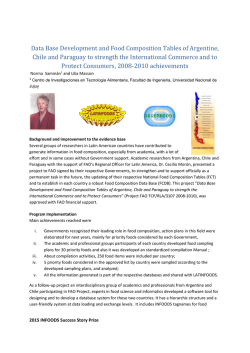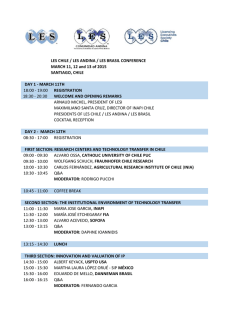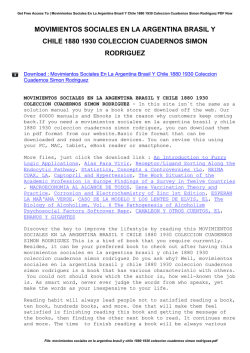
Check List the journal of
Check List NOTES ON GEOGRAPHIC DISTRIBUTION the journal of biodiversity data Check List 11(2): 1576, February 2015 doi: http://dx.doi.org/10.15560/11.2.1576 ISSN 1809-127X © 2015 Check List and Authors Histiotus magellanicus (Chiroptera: Vespertilionidae) is not restricted to Subantarctic forests: first record for the Coastal Maulino Forest in central Chile Annia Rodríguez-San Pedro1*, Rubén M. Barquez2 and Javier A. Simonetti1 1 Universidad de Chile, Facultad de Ciencias, Departamento de Ciencias Ecológicas, Casilla 653, Santiago, Chile 2 Programa de Investigaciones de Biodiversidad Argentina (PIDBA), Facultad de Ciencias Naturales, Universidad Nacional de Tucumán, Argentina, and Consejo Nacional de Investigaciones Científicas y Técnicas (CONICET) * Corresponding author: E-mail: [email protected] Abstract: The southern Big-Eared Brown Bat, Histiotus magellanicus, is a poorly known vespertilionid occurring only in southern Chile and Argentina, where it appears to be restricted to Valdivian Temperate Forests and Magellanic Subpolar Forests. Here we report the first record of H. magellanicus in the Maulino Temperate Forest of central Chile, a Mediterranean-climate ecosystem, suggesting that the species might not be exclusive to subantarctic forests, as previously thought. This constitutes the northernmost continental record for the species, extending its range ca. 400 km the previous known northern locality. (1978) considered Histiotus magellanicus as a subspecies of H. montanus (Philippi & Landbeck, 1861). However, it is currently recognized as a valid species by Barquez et al. (1993, 1999) based on morphological characters. Histiotus magellanicus clearly differs from its sympatric congener H. montanus by its shorter ears, without any connecting band between them, and the darker hair color (Barquez 2006; Díaz et al. 2011). Histiotus magellanicus is classified as Least Concern by the IUCN Red List of Threatened Species (Barquez and Díaz 2008), despite not being evaluated in Chile and Argentina. This fact might be due to the lack of information about their geographic distribution range. Two females of H. magellanicus were recorded in the Reserva Nacional Los Queules (35°59′15″ S, 072°41′43″ W; Figure 1), located in the Cordillera de la Costa, 20 km southwest from the Comuna Pelluhue, province of Cauquenes in the Maule region, central Chile. The predominant habitat within the reserve is a mature mixed forest composed principally of hualo Nothofagus glauca, roble N. obliqua and evergreen sclerophyllous tree species. Surrounding the reserve are Monterrey pine plantations, scattered fragments of Maulino forest and agricultural lands. Specimens were captured with a mist net during nocturnal samplings between January of 2010 and January of 2012. All individuals were released in the capture sites after taking their measurements. The characters of the two individuals collected are identical to those reported by Díaz et al. (2011) with dorsal and ventral coloration very dark, ear length less than 25 mm clearly separated from each other. External measurements are: Female 1: body weight 15 g; total length 107 mm; ear length, 18 mm; forearm length: 45.5 mm; wingspan 300 mm and Female 2: body weight 14.5 g; total length 112 mm; ear length, 19 mm; forearm length: 45.6 mm; wingspan 310 mm (Figure 2). Key words: Chilean temperate forest, distribution range, new record, Southern Big-Eared Brown Bat The Southern Big-Eared Brown Bat, Histiotus magellanicus (Philippi, 1866), is a poorly known vespertilionid, endemic to southern Chile and Argentina (Simmons 2005; Barquez 2006; Ossa and Díaz 2014) where it appears to be restricted to Valdivian Temperate Forests and Magellanic Subpolar Forests (Giménez et al. 2012; Barquez et al. 2013). Its type locality is located in the Magellan Strait, southern Chile (Philippi 1866; Osgood 1943). In Argentina, the distribution of H. magellanicus extends from Tierra del Fuego (54° S) to the province of Neuquén (38° S) (Barquez and Zoratti 1998; Giménez et al. 2012). In Chile, the species ranges from Cabo de Hornos (Magellan region, 53°S) northward to the province of Valdivia (39° S, Los Ríos region, including Chiloé Island (Cabrera 1958; Peña and Barria 1972). Mann Fischer (1978) includes Concepción (Bío-Bío region) in the probable distribution of H. magellanicus in Chile, although no specimen has been recorded in this region. Osgood (1943), Cabrera (1958), and Mann Fischer Check List | www.biotaxa.org/cl 1 Volume 11 | Number 2 | Article 1576 Rodríguez-San Pedro et al. | First record of Histiotus magellanicus from central Chile Figure 1. Records of Histiotus magellanicus in southern South America. Black circles refer to published data and the gray circle refers to a new record at Reserva Nacional Los Queules in the Cordillera de la Costa of central Chile. The specimens reported here extends substantially the known limit of the species distribution by ca. 400 km northward and represents the first record of H. magellanicus in the Maulino Temperate Forest, a Mediterranean-climate ecosystem in the Cordillera de la Costa of central Chile, suggesting that this species might not be exclusive to Subantarctic forests, as previously though (Giménez et al. 2012; Ossa and Díaz 2014; Barquez et al. 2013). In addition, the record of this species in the Maulino Forest shows that the darker color of H. magellanicus would not necessarily be associated with humid environments (Handley and Gardner 2008) and therefore could be considered as a valid differential character between sympatric congener H. montanus (Barquez et al. 1993, 1999). This report contributes significantly to the knowledge of the geographical distribution of H. magellanicus and increases the bat diversity of the Maule region to seven species, further emphasizing the deficiency of information on bats and the need of additional ecological studies in the region. The finding of more southern species, typical of the Valdivian forest, such as Dromiciops gliroides, Geoxus valdivianus, and Irenomis tarsalis (Muridae), Tachymenis chilensis Check List | www.biotaxa.org/cl Figure 2. Ventral (A) and dorsal (B) view of a Histiotus magellanicus female captured at Reserva Nacional Los Queules in the Cordillera de la Costa of central Chile. (Colubridae), Liolaemus cyanogaster (Iguanidae), Protosphindus bellus (Sphindidae), and Pteroderes tuberosa (Ulodidae) (Saavedra and Simonetti 2000, 2001; Simonetti 2001; Grez et al. 2003; Rubio et al. 2004) along with H. magellanicus, previously regarded as an endemic of the Subantarctic forests, suggests that the Maulino forest is the current northernmost limit of the Valdivian fauna, and also reinforces the importance of this reserve for the conservation of this unique biota. ACKNOWLEDGEMENTS We are grateful to Y. Cerda, R. Zúñiga and F. Campos for their help in field. We also give thanks to Corporación Nacional Forestal VII Región for granting permits to work on their states. ARSP was a Doctoral Fellow from CONICYT, Chile. 2 Volume 11 | Number 2 | Article 1576 Rodríguez-San Pedro et al. | First record of Histiotus magellanicus from central Chile LITERATURE CITED America, Volume 1, marsupials, xenarthrans, shrews, and bats. Chicago: The University of Chicago Press. Mann Fischer, G. 1978. Los pequeños mamíferos de Chile. Gayana Zoología 40: 1–342. Osgood, W. H. 1943. The mammals of Chile. Field Museum of Natural History, Zoological series 30: 1–268. doi: 10.5962/bhl.title.3842 Ossa, G. and F. Díaz. 2014. Histiotus magellanicus (Philippi 1866), un ignorado dentro de la mastofauna chilena. La Chiricoca 17: 4–6. Peña, L. and G. Barria. 1972. Presencia de Histiotus montanus magellanicus Philp. y de Myotis chiloensis chiloensis Waterh (Chiroptera), al sur del Estrecho de Magallanes. Anales del Museo de Historia Natural de Valparaiso 5: 201–202. Philippi, R.A. 1866. Ueber ein paar neue Chilenische Säugethiere. Archiv Für Naturgeschichte 32(1): 113–117. http://biodiversitylibrary. org/page/7060614 Rubio, A., F. Zorondo-Rodríguez and J.A. Simonetti. 2004. Geographic distribution: Liolaemus cyanogaster cyanogaster. Herpetological Review 35: 288. Saavedra, B. and J.A. Simonetti. 2000. A northern and threatened population of Irenomys tarsalis (Mammalia: Rodentia) from central Chile. Zeitschrift fur Saugetierkunde 65(4): 243–245. Saavedra, B. and J.A. Simonetti. 2001. New records of Dromiciops gliroides (Microbiotheria: Microbiotheriidae) and Geoxus valdivianus (Rodentia: Muridae) in central Chile: their implications for biogeography and conservation. Mammalia 65(1): 96–100. Simmons, N.B. 2005. Order Chiroptera; pp. 312–529, in: D. E. Wilson and D.M. Reeder (eds). Mammal species of the world: a taxonomic and geographic reference. Baltimore: The John Hopkins University Press. Simonetti, J.A. 2001. Presence of Tachymenis chilensis chilensis at Reserva Nacional Los Queules, Central Chile. Gayana Zoológica 65: 219–220. Barquez, R.M. 2006. Orden Chiroptera; pp. 56–86, in: R.M Barquez, M.M Díaz and R.A Ojeda (eds). Mamíferos de Argentina: sistemática y distribución. Sociedad Argentina para el Estudio de los Mamíferos (SAREM), Mendoza. Barquez, R.M., M.N. Carbajal, M. Failla and M.M. Díaz. 2013. New distributional records for bats of the argentine Patagonia and the southernmost known record for a molossid bat in the world. Mammalia 77: 119–126. doi: 10.1515/mammalia-2012-0053 Barquez, R.M., N.P. Giannini and M.A. Mares. 1993. Guide to the bats of Argentina. Norman: Oklahoma Museum of Natural History. 132 pp. Barquez, R. M., M. A. Mares and J. K. Braun. 1999. The bats of Argentina. Special Publications of the Museum of Texas Tech University 42: 1–288. Barquez, R and M. Díaz. 2008. Histiotus magellanicus; in: IUCN, 2013. IUCN Red List of Threatened Species. Version 2013.2. Accessed at http://www.iucnredlist.org, 26 April 2014. Barquez, R. and C. Zoratti. 1998. La distribución de los murciélagos del genero Histiotus (Vespertilionidae) en la provincia de Santa Cruz, Argentina; pp. 77, in: Libro de Resúmenes XIII Jornadas Argentinas de Mastozoología. Argentina. Mendoza: Sociedad Argentina para el Estudio de los Mamíferos (SAREM). Cabrera, A. 1958. Catálogo de los mamíferos de América del Sur. Museo Argentino de Ciencias Naturales “Bernardino Rivadavia” e Instituto Nacional de Investigación de las Ciencias Naturales, Ciencias Zoológicas 4: 1–308. Díaz, M.M., L.F. Aguirre and R.M. Barquez. 2011. Clave de identificación de los murciélagos del cono sur de Sudamérica. Cochabamba: Centro de Estudios en Biología Teórica y Aplicada. 94 pp. Giménez, A., N. Giannini, M. Schiaffini and G. Martin. 2012. Records of the rare Histiotus magellanicus (Chiroptera, Vespertilionidae) and other bats from central Patagonia, Argentina. Mastozoología Neotropical 19: 213–224. http://www.redalyc.org/ pdf/457/45725085001.pdf Grez, A.A., P. Moreno and M. Elgueta. 2003. Coleópteros (Insecta: Coleoptera) epigeos asociados al bosque Maulino y plantaciones de pino aledañas. Revista Chilena de Entomología 29: 9–18. Handley Jr., C.O. and A.L. Gardner. 2008. Genus Histiotus P. Gervais, 1856; pp. 450–457, in: A.L. Gardner (ed.) Mammals of South Check List | www.biotaxa.org/cl Authors’ contribution statement: ARSP collected the specimens and took the photos. RMB identified the specimens. ARSP wrote the text, made the map and prepared the figures. RMB and JAS discussed content and revised the text. JAS funded the fieldwork. Received: May 2014 Accepted: January 2015 Editorial responsibility: Paúl M. Velazco 3 Volume 11 | Number 2 | Article 1576
© Copyright 2026




